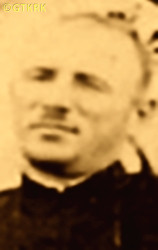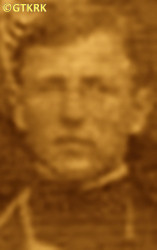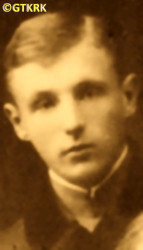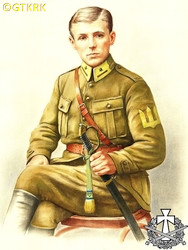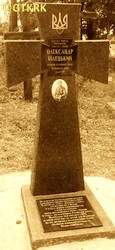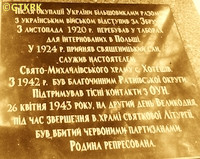Roman Catholic
St Sigismund parish
05-507 Słomczyn
85 Wiślana Str.
Konstancin deanery
Warsaw archdiocese, Poland
full list:
displayClick to display full list

searchClick to search full list by categories
wyświetlKliknij by wyświetlić pełną listę po polsku

szukajKliknij by przeszukać listę wg kategorii po polsku

Martyrology of the clergy — Poland
XX century (1914 – 1989)
personal data
surname
BILECKI
forename(s)
Alexander (pl. Aleksander)
function
presbiter (i.e. iereus)
creed
Eastern Orthodox Church ORmore on
en.wikipedia.org
[access: 2014.09.21]
diocese / province
Volyn OR eparchy (Polish Autocephalous Orthodox Church PAOC)more on
pl.wikipedia.org
[access: 2021.12.19]
date and place
of death
26.04.1943

Khoteshivtoday: Kamin‐Kashyrskyi urban hrom., Kamin‐Kashyrskyi rai., Volyn obl., Ukraine
more on
uk.wikipedia.org
[access: 2024.03.15]
details of death
After the end of World War I, from 1920 a soldier of the Active Army of the Ukrainian People's Republic UPR. During the Polish–Russian War of 1919‐1920 fought in the ranks of the 4th Cavalry Regiment of the 4th Kiev Division on the Polish side. In 11.1920 the transformed 4th Kiev Rifle Division attempting to regain Ukraine — after the Polish victory in the Battle of Warsaw around 15.08.1920 (known also as „Miracle on the Vistula”) — was defeated in the battles with the Russians and crossed back the Zbruch River and entered Polish territory.
Interned, among others in Internment Camp No. 6 in Aleksandrów Kujawski (existed from 06.12.1920‐09.10.1921).
After the German and Russian invasion of Poland in 09.1939 and the start of World War II, after the German attack on 22.06.1941 on its erstwhile ally, the Russians, and the start of the German occupation, was supposed to — according to Ukrainian sources — play an „important role” in the formation of the first local Ukrainian units of genocidal organization OUN/UPA.
During the «Genocidium Atrox» — the genocide committed by Ukrainians, known also as „Volyn massacres”, on the defenseless Polish population (in his Khoteshiv parish several Poles were actually murdered by Ukrainians) — his church was attacked by a Russian partisan unit, consisting of local Ukrainians (who, during the Russian occupation of 1939‐1941, did not want to be forcibly conscripted into the Russian army and hid in the forests; later, after the beginning of the German occupation, did not want to join the OUN/UPA, and finally were absorbed by the Russian partisans).
On the second day after Easter, a Ukrainian partisan on horseback rode into the church — where baptism ceremonies were taking place — ordered the gathered people to lie down on the floor, and then shot the priest.
The fatally wounded man managed to get to the sacristy, where tried to take off his church robes.
His sexton was murdered along with him.
The family was sent to Siberia by the Russians in 1947 for supporting the OUN/UPA.
cause of death
mass murder
perpetrators
Russians / Ukrainians
sites and events
«Genocidium Atrox»Click to display the description, Ribbentrop‐MolotovClick to display the description
date and place
of birth
10.04.1903

(Novohrad‐Volynskyi Uyezd)part of Volyn governorate
today: Zviahel rai., Zhytomyr obl., Ukraine
more on
en.wikipedia.org
[access: 2024.03.15]
alt. dates and places
of birth
1900
presbyter (holy orders)
ordination
08.11.1924

positions held
1942 – 1943
dean — Ratnetoday: Ratne hrom., Kovel rai., Volyn obl., Ukraine
more on
en.wikipedia.org
[access: 2021.09.17] OR deanery
15.06.1936 – 1943
parish priest — Khoteshivtoday: Kamin‐Kashyrskyi urban hrom., Kamin‐Kashyrskyi rai., Volyn obl., Ukraine
more on
uk.wikipedia.org
[access: 2024.03.15] ⋄ St Michael the Archangel OR parish ⋄ Ratnetoday: Ratne hrom., Kovel rai., Volyn obl., Ukraine
more on
en.wikipedia.org
[access: 2021.09.17] OR deanery
protoiereus (Eng. first priest) — Polish Autocephalous Orthodox Church PACP — dignity conferment (prob.)
from 1935
parish priest — Sharashovatoday: Sharashova ssov., Pruzhany dist., Brest reg., Belarus
more on
en.wikipedia.org
[access: 2024.03.15] ⋄ St Nicholas the Wonderworker OR parish
1928 – 1935
parish priest — Tynnetoday: Nemovychi hrom., Sarny rai., Rivne obl., Ukraine
more on
uk.wikipedia.org
[access: 2024.03.15] ⋄ St Paraskeva OR parish
c. 1927
parish priest — Bilska Volyatoday: Varash urban hrom., Varash rai., Rivne obl., Ukraine
more on
uk.wikipedia.org
[access: 2024.03.15] ⋄ St Paraskeva OR parish ⋄ Sarny 2nd distr.Orthodox deanery name
today: Sarny rai., Rivne obl., Ukraine
more on
en.wikipedia.org
[access: 2021.09.17] OR deanery
from 1926
parish priest — Boremetstoday: Yaroslavychi hrom., Dubno rai., Rivne obl., Ukraine
more on
uk.wikipedia.org
[access: 2024.03.15] ⋄ Intercession of the Blessed Virgin Mary OR parish
from 1925
parish priest — Haluziyatoday: Prylisne hrom., Kamin‐Kashyrskyi rai., Volyn obl., Ukraine
more on
uk.wikipedia.org
[access: 2024.03.15] ⋄ St Seraphim of Sarov OR parish
priest — Żmudźtoday: Żmudź gm., Chełm pov., Lublin voiv., Poland
more on
en.wikipedia.org
[access: 2024.03.15] ⋄ Ascension of the Lord OR parish
08.11.1924
presbiter (Eng. priest, i.e. iereus) — Polish Autocephalous Orthodox Church PACP — priesthood cheirotonia, i.e. ordination
till 1924
student — Kremenetstoday: Kremenets urban hrom., Kremenets rai., Ternopil obl., Ukraine
more on
en.wikipedia.org
[access: 2020.10.18] ⋄ philosophy and theology, Orthodox Theological Seminary
1920 – c. 1921
soldier — Ukrainian People's Army
pupil — Zhytomyrtoday: Zhytomyr urban hrom., Zhytomyr rai., Zhytomyr obl., Ukraine
more on
en.wikipedia.org
[access: 2021.09.17] ⋄ Orthodox Theological School
married — four children
sites and events
descriptions
«Genocidium Atrox»: In 1939‐1947, especially in 1943‐1944, independent Ukrainian units, mainly belonging to genocidal Ukrainian organizations OUN (political arm) and UPA (military arm), supported by local Ukrainian population, murdered — often in extremely brutal way — in Volyn and surrounding regions of pre‐war Poland, from 130,000 to 180,000 Poles, all civilians: men, women, children, old and young. Polish‐Ukrainian conflict that openly emerged during and after World War I (in particular resulting in Polish‐Ukrainian war of 1918‐1919), that survived and even deepened later when western Ukraine became a part Poland, exploded again after the outbreak of the World War II in 09.1939. During Russian occupation of 1939‐1941, when hundreds of thousands of Poles were deported into central Russia, when tens of thousands were murdered (during so‐called Katyń massacres, among others), this open conflict had a limited character, helped by the fact that at that time Ukrainians, Ukrainian nationalists in particular, were also persecuted by the Russians. The worst came after German‐Russian war started on 22.06.1941 and German occupation resulted. Initially Ukrainians supported Germans (Ukrainian police was initiated, Ukrainians co—participated in extermination of the Jews and were joining army units fighting alongside Germans). Later when German ambivalent position towards Ukraine became apparent Ukrainians started acting independently. And in 1943 one of the units of aforementioned Ukrainian OUN/UPA organization, in Volyn, started and perpetrated a genocide of Polish population of this region. In mere few weeks OUN/UPA murdered, with Germans passively watching on the sidelines, more than 40,000 Poles. This strategy was consequently approved and adopted by all OUN/UPA organisations and similar genocides took place in Eastern Lesser Poland (part of Ukraine) where more than 20,000 Poles were slaughtered, meeting however with growing resistance from Polish population. Further west, in Chełm, Rzeszów, etc. regions this genocide turned into an extremely bloody conflict. In general genocide, perpetrated by Ukrainian nationalists, partly collaborating with German occupants, on vulnerable Polish population took part in hundreds of villages and small towns, where virtually all Polish inhabitants were wiped out. More than 200 priests, religious and nuns perished in this holocaust — known as «Genocidium Atrox» (Eng. „savage genocide”) The nature and purpose of genocide is perhaps best reflected in the song sung by the murderers: „We will slaughter the Poles, we will cut down the Jews, we must conquer the great Ukraine” (ukr. „Поляків виріжем, Євреїв видусим, велику Україну здобути мусим”). This holocaust and conflict ended up in total elimination of Polish population and Polish culture from Ukraine, in enforced deportations in 1944‐1945 of remaining Poles from Ukraine and some Ukrainians into Ukraine proper, and finally in deportation of Ukrainians from East‐South to the Western parts of Polish republic prl by Commie‐Nazi Russian controlled Polish security forces („Vistula Action”). (more on: www.swzygmunt.knc.plClick to attempt to display webpage
[access: 2021.06.20])
Ribbentrop‐Molotov: Genocidal Russian‐German alliance pact between Russian leader Joseph Stalin and German leader Adolf Hitler signed on 23.08.1939 in Moscow by respective foreign ministers, Mr. Vyacheslav Molotov for Russia and Joachim von Ribbentrop for Germany. The pact sanctioned and was the direct cause of joint Russian and German invasion of Poland and the outbreak of the World War II in 09.1939. In a political sense, the pact was an attempt to restore the status quo ante before 1914, with one exception, namely the „commercial” exchange of the so‐called „Kingdom of Poland”, which in 1914 was part of the Russian Empire, fore Eastern Galicia (today's western Ukraine), in 1914 belonging to the Austro‐Hungarian Empire. Galicia, including Lviv, was to be taken over by the Russians, the „Kingdom of Poland” — under the name of the General Governorate — Germany. The resultant „war was one of the greatest calamities and dramas of humanity in history, for two atheistic and anti‐Christian ideologies — national and international socialism — rejected God and His fifth Decalogue commandment: Thou shall not kill!” (Abp Stanislav Gądecki, 01.09.2019). The decisions taken — backed up by the betrayal of the formal allies of Poland, France and Germany, which on 12.09.1939, at a joint conference in Abbeville, decided not to provide aid to attacked Poland and not to take military action against Germany (a clear breach of treaty obligations with Poland) — were on 28.09.1939 slightly altered and made more precise when a treaty on „German‐Russian boundaries and friendship” was agreed by the same murderous signatories. One of its findings was establishment of spheres of influence in Central and Eastern Europe and in consequence IV partition of Poland. In one of its secret annexes agreed, that: „the Signatories will not tolerate on its respective territories any Polish propaganda that affects the territory of the other Side. On their respective territories they will suppress all such propaganda and inform each other of the measures taken to accomplish it”. The agreements resulted in a series of meeting between two genocidal organization representing both sides — German Gestapo and Russian NKVD when coordination of efforts to exterminate Polish intelligentsia and Polish leading classes (in Germany called «Intelligenzaktion», in Russia took the form of Katyń massacres) where discussed. Resulted in deaths of hundreds of thousands of Polish intelligentsia, including thousands of priests presented here, and tens of millions of ordinary people,. The results of this Russian‐German pact lasted till 1989 and are still in evidence even today. (more on: en.wikipedia.orgClick to attempt to display webpage
[access: 2015.09.30])
sources
personal:
tyzhden.uaClick to attempt to display webpage
[access: 2024.03.15], volyn.church.uaClick to attempt to display webpage
[access: 2024.03.15], www.volynpost.comClick to attempt to display webpage
[access: 2024.03.15]
original images:
tyzhden.uaClick to attempt to display webpage
[access: 2024.03.15], tyzhden.uaClick to attempt to display webpage
[access: 2024.03.15], tyzhden.uaClick to attempt to display webpage
[access: 2024.03.15], tyzhden.uaClick to attempt to display webpage
[access: 2024.03.15], volyn.church.uaClick to attempt to display webpage
[access: 2024.03.15], volyn.church.uaClick to attempt to display webpage
[access: 2024.03.15]
LETTER to CUSTODIAN/ADMINISTRATOR
If you have an Email client on your communicator/computer — such as Mozilla Thunderbird, Windows Mail or Microsoft Outlook, described at WikipediaPatrz:
en.wikipedia.org, among others — try the link below, please:
LETTER to CUSTODIAN/ADMINISTRATORClick and try to call your own Email client
If however you do not run such a client or the above link is not active please send an email to the Custodian/Administrator using your account — in your customary email/correspondence engine — at the following address:

giving the following as the subject:
MARTYROLOGY: BILECKI Alexander
To return to the biography press below:
 Click to return to biography
Click to return to biography








